Nestled between the border of Brazil and Argentina is the world’s largest system of waterfalls – Iguazu Falls or Foz do Iguaçu in Portuguese and Las Cataratas del Iguazú in Spanish. Together, the national parks contain 275 individual waterfalls.
If you’ve ever been to Niagara Falls in New York, picture the falls there and multiply it by 10 to understand the vastness of Iguazu Falls.
The Iguazu Falls divide the Iguazu River into a lower and upper section. Most of the waterfalls (80%) are on the Argentina side while Brazil claims the best views. Together the parks are referred to as the National Park of Iguazu.
To have the most memorable Iguazu Falls experience, it is highly encouraged to visit both counties’ respective parks. This blog post will detail the best itinerary for making the most of your time in Brazil and Argentina’s parks.
The legend of Iguazu Falls
Legend has it that Iguazu Falls came to be when the Serpent God, who lived in the river, demanded to marry a woman named Naipi. He thought she was the most beautiful woman he’d ever seen. But Naipi was in love with another man, Taruba.
The two lovers fled by canoe on the Iguazu River but before they could escape, the Serpent God’s anger caused the river and earth to divide, and the falls were formed.
At this moment, Naipi was turned into a waterfall and Taruba into a tree on the river’s edge. Thus the Serpent God left the lovers painfully close but never able to touch again.
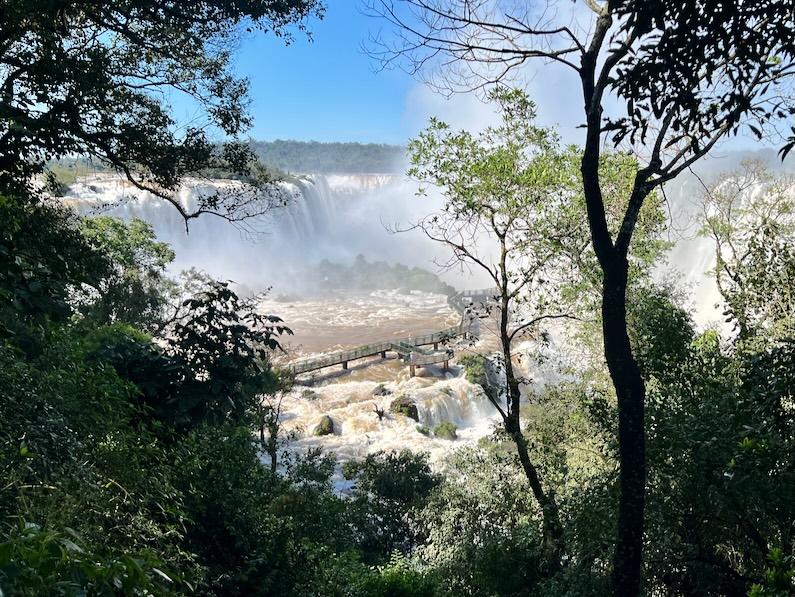
Iguazu Falls in Brazil
Where is Iguazu Falls and How to Get There
The falls can be reached from two different towns in two different countries! Who doesn’t love options?
More specifically, Iguazu Falls straddles the border of the Brazilian state of Paraná and the Argentine province of Misiones.
Tourists base themselves in either the city of Foz do Iguaçu, Brazil, or in Puerto Iguazú, Argentina.
Both cities have airports that are serviced by major cities in their respective countries.
Iguazu Falls borders 3 countries: Brazil, Argentina and Paraguay
Border Crossing
If you are planning to visit both sides, which I highly recommend, you will need to pass through a border crossing outside of the parks.
It is not possible to visit both sides without leaving one of the parks.
There are fewer than 20 miles between the park entrances but expect at least an hour’s drive depending on where you are staying due to the border crossing.
If you are traveling in your private vehicle expect longer wait times (this is not recommended).
Taxis and buses have a specific lane for crossing. However, if you go by bus you will need to wait for everyone on your bus to clear customs before continuing.
Border Crossing in Taxi
We stayed at the Sanma Hotel, just 5 minutes walking from Brazil’s park entrance! From the Sanma Hotel, it takes ~1.5 hours to arrive at the Argentine park entrance. The same taxi then picked us up later in the afternoon and took us back to the Sanma Hotel in Brazil.
For the day, the taxi cost $80 and the Sanma Hotel front desk arranged it for us. If you are staying in the city of Foz do Iguaçu, a taxi will be cheaper and quicker since you are already closer to the border.
Border Crossing in Public Bus
For us the taxi service was very worthwhile, especially if you are not staying in downtown Foz do Iguaçu, Brazil, or Puerto Iguazú, Argentina.
Both cities have a central bus station where the bus departs daily, every 30 minutes.
Bus Stations:
- In Foz do Iguaçu, Brazil – Terminal de Transporte Urbano (TTU)
- In Puerto Iguazú, Argentina – Terminal de Buses De Puerto Iguazú
If you would prefer to take a taxi but wish the price was lower, ask around your hotel or the front desk to see if anyone else is also traveling to and from the other park and willing to split the ride.
Where to Stay in Iguazu Falls
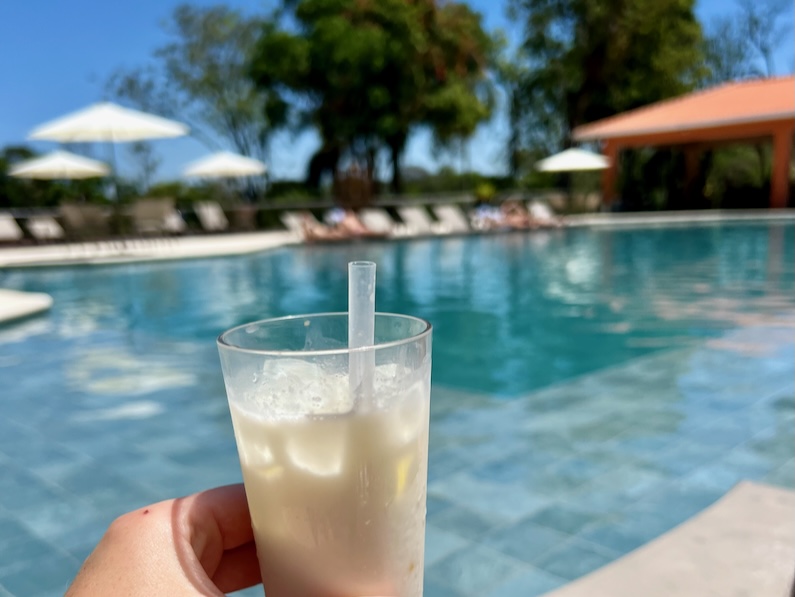
The Pool at the Sanma Hotel
Stay in Brazil or Argentina
Deciding to base yourself on either the Brazil or Argentina side depends on a couple factors:
- Language – Do you speak Spanish or Portuguese?
- Prior Travel – Are you traveling from within Brazil or Argentina already?
- Tourist Visa – Are you required to obtain a tourist visa to enter Brazil? (more on this at the end)
We chose Brazil since we were traveling from Florianópolis, Brazil, and our Portuguese is much better than our Spanish.
Sanma Hotel in Brazil
The Sanma Hotel was an amazing hotel for a couple of reasons:
- Proximity to Brazil National Park – It is so close to the park in Brazil. Only a 10-minute/half-mile walk to the visitor center.
- Proximity to Parque das Aves – Even closer is the Parque das Aves, a conservation center for Atlantic Rainforest birds. It is so close that every morning it sounded like the soundtrack to the Rainforest Cafe at Downtown Disney was playing outside our hotel room.
- Modern Hotel – It was recently renovated with a modern pool, restaurant and bar, and many other amenities. The lobby feels like a luxurious lodge.
- Breakfast Included – Starting your day with a full belly before hitting the parks is essential. Breakfast is included – buffet and made-to-order dishes.
- Green Space – There is lots of green space on the property including a short trail and soccer field.
If you don’t want to splurge to stay inside the park but still want a comfortable hotel with amenities, Sanma Hotel is a great accomdation.
Cheap and Convenient
If you plan on only using the bus during your time in Foz do Iguaçu, Brazil, or Puerto Iguazú, Argentina, staying near the city bus terminals will be the most convenient option.
Luxurious and Exclusive
Each side of the park has a luxury hotel with perks almost worth the price to stay there.
Brazil – Hotel das Cataratas, A Belmond Hotel
Argentina – Gran Meliá Iguazú
Staying at either of these hotels comes with a steep price tag but they offer exclusive experiences, views, and access inside the national parks that only hotel guests can take advantage of.
If you are an Amex cardholder, check your travel benefits for deals at either of these hotels.

American Express Travel Advertisement for Belmond Hotel
How Many Days at Iguazu National Park
- 1 Day – Just enough time to visit the Argentina OR Brazil side of the park, but definitely not both.
- 2 days – More flexibility to visit both parks but no wiggle room to account for a bad weather day or travel delay.
- 3 days – The optimal number of days to allocate for this trip. Allows time to visit both parks and also do a boat tour or check out the Parque das Aves (bird park) in Brazil.
- 4 days – Spending 4 days exploring the parks and surrounding area makes a for a relaxed trip. With 4 days, visitors have the luxury of spending 2 days exploring the larger Argentine side, 1 day in the Brazil side, and 1 day across the border in Paraguay, if that is also of interest.
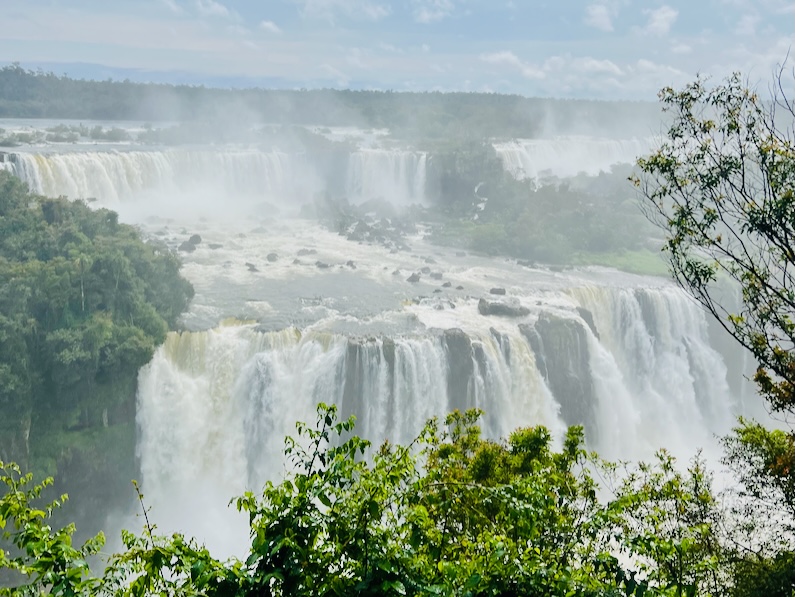
Waterfalls in Argentina
4-Day Itinerary Highlights
Day 1 – Arrive in Foz do Iguaçu, Brazil in the evening and check in to Sanma Hotel.
Day 2 – Breakfast and relaxed morning at the hotel, walk to Parque das Aves (bird park), then walk to the Iguazu Falls visitor center on the Brazil side.
Day 3 – Visit Argentina’s National Park of Iguazu.
Day 4 – Return to Brazil’s National Park when the doors open to explore the falls crowd-free, after enjoy the afternoon at the Sanma’s pool before an evening flight.
4 days was plenty of time and gave us some breathing room to adjust plans based on the weather, which we ended up doing!
Visitors can easily reduce the days to 3 or even 2 depending on flight schedules.
You only need more than 4 days if you are also wanting to visit Paraguay or other attractions besides the national parks.
How Much Time in Each Park
Iguazu Falls National Park in Brazil
Visitors should plan to dedicate 2-3 hours to walk the pathways and view the waterfalls from Brazil’s national park. If the park is very crowded, it will take longer to progress along the viewing trails.
Account for extra time if you want to add a boat excursion or the Porto Canoas Restaurant to the itinerary.
Iguazu Falls National Park in Argentina
The Argentine side really deserves a full day, especially if crossing the border from Brazil. You could easily spend 2 days if you want to do all the trails and a boat excursion.
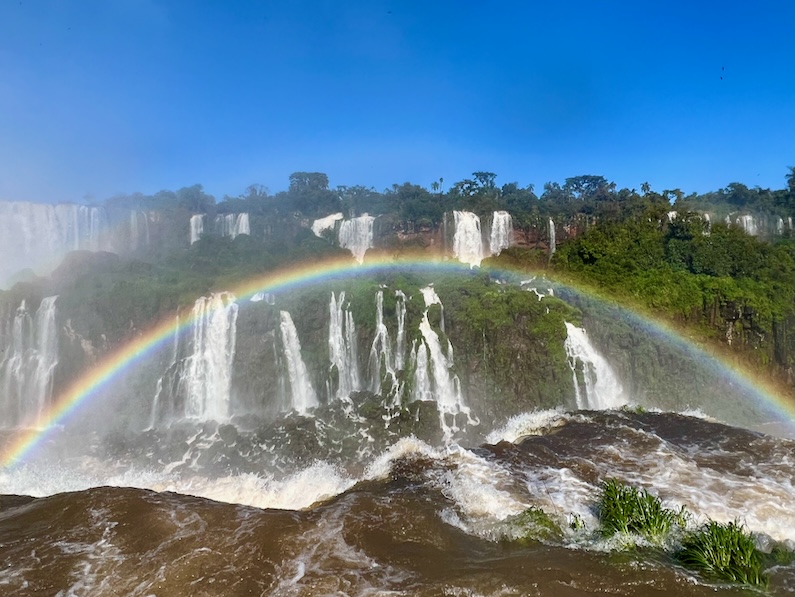
Rainbow over the falls in Brazil
Brazil's Iguazu Falls National Park
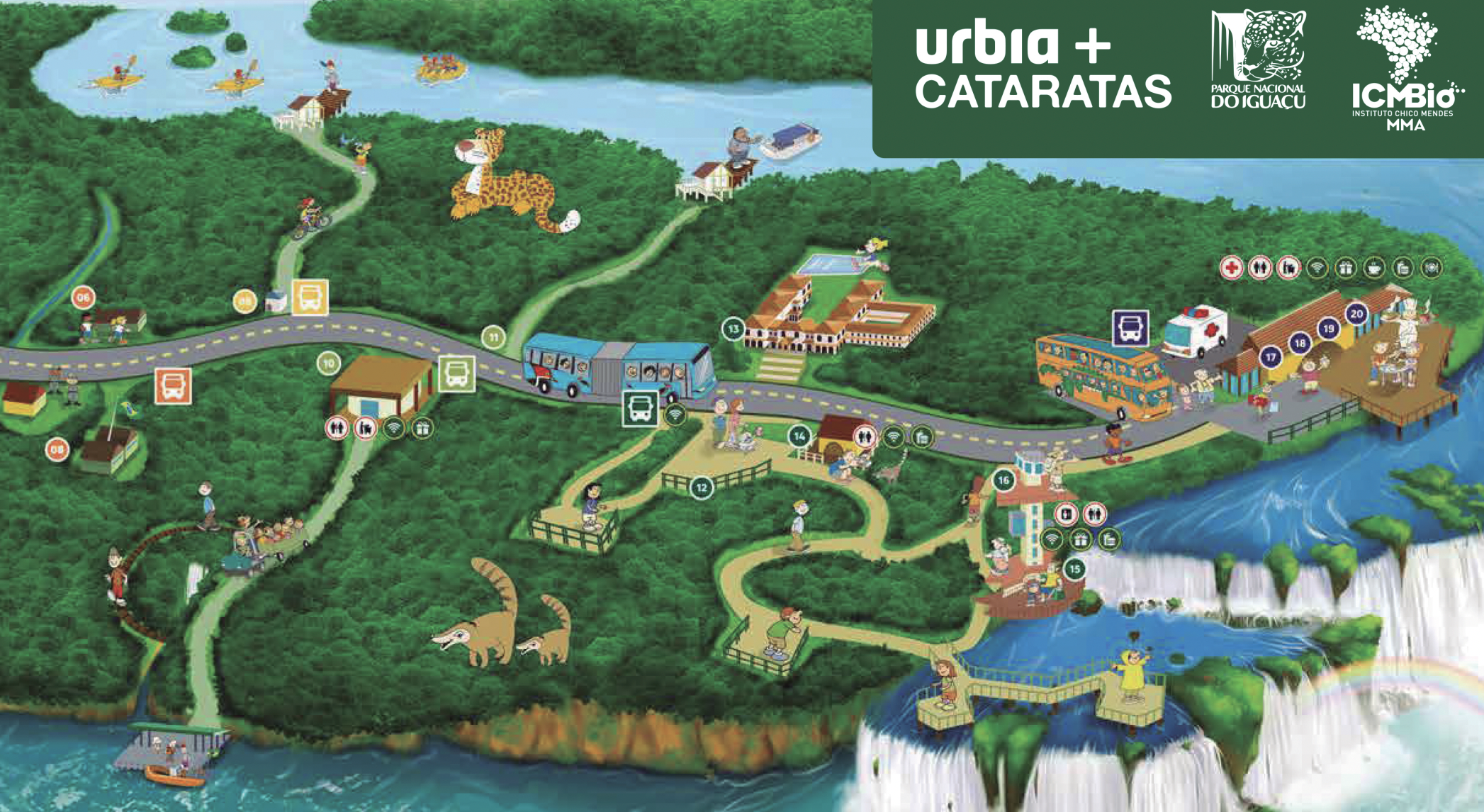
Map of Iguazu Falls' Park in Brazil
The Brazil side of the park is very easy to navigate. Tickets can be purchased online ahead of time or at the Visitor Center kiosks before entering the park.
Next, the majority of visitors take the national park bus to the Trilha das Cataratas (#12 on the map) bus stop. This is where the first glimpse of the falls comes into view.
Visitors continue along the paved trail, getting closer to the roar of the falls with each step.
The other option is to get off at the Espaco Naipi (#16 on the map) bus stop and work your way backward from the falls. You might be moving against the flow of most visitors but there is a big advantage to getting off the bus at Espaco Naipi.
First Visit to Brazil's Iguazu Falls
During our first visit to the Brazil side, we just went with the flow and got off at the Trilha das Cataratas stop.
It was raining, so not too crowded but we still had to wait at most of the popular photo spots along the trail.
We knew we were returning to the Brazil side of the park again so we weren’t too concerned with getting the most perfect photos.
Lucky for us, just as we got off the bus at Trilha das Cataratas, a family of Coatis made their way out of the bushes and up a tree in front of everyone. It was like something you would see in Disney at the start of a ride.
There are advisory signs throughout both parks warning visitors to not approach, feed or touch the coatis. They can be agressive, especially around food.
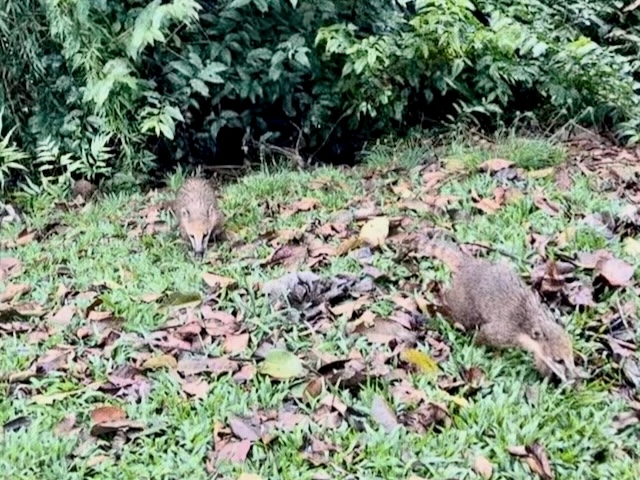
Coatis in Iguazu Falls
A Strategic Visit to Iguazu Falls in Brazil
Our second visit to the Brazil side was much more strategic. We wanted to have unobstructed views of the falls, capture photos without other people in them, and avoid the crowds.
If you only have one chance to visit the Brazil side of the park, and you are not staying at the Belmond Hotel I recommend the following plan:
- Buy Ticket Online – Purchase your park entry ticket online to avoid the lines and sold-out entry times of the day.
- Don’t Wait to Buy – Buy tickets in advance to secure the first entry time to the park.
- Arrive to Park Early – Arrive at the visitor center at least 30 minutes before your entry time to get in line for the park bus (yes the line really did start forming this early). During the week, the park opens at 9 am with the first entry time at 9:10 am. On the weekends, the park opens at 8:30 am. The parking lot opens daily at 8 am.
- Espaço Naipi Bus Stop – Take the park bus to the Espaço Naipi stop. Next, use the elevator to go down to the first viewing platform called Salto Floriano (#15 on the map), and then continue down to the Devil’s Throat platform.
Following this plan, we were the very first people at the Salto Floriano viewing platform. It felt much more surreal and peaceful being so close to the falls without massive crowds surrounding us. We actually had to wait for another couple to join us to have someone take our photo for us.
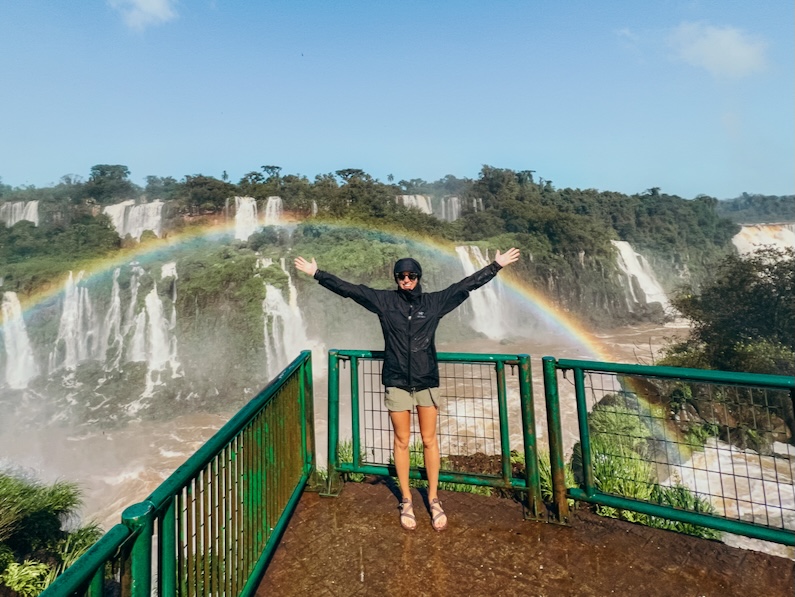
Other Ways to See the Falls in Brazil
Brazil’s Iguazu Falls National Park recently added two new ways for visitors to see the falls in a more intimate expereince.
Dawn at the Falls + Breakfast at Porto Canoas
Previously only guests at the Belmond Hotel had access to the falls before the park’s official opening time. Now, visitors who purchase this ticket can enter the park starting at 6am to watch the sunrise over the falls and then enjoy breakfast at the Porto Canoas Restuarant.
For more information about Dawn at the Falls visit the official ticket sales webpage.
Sunset at the Falls
Following park’s closing time at 4pm, visitors with Sunset at the Falls tickets can access the park’s trails and viewing platfroms between 5pm and 7:30pm. This ticket includes a welcome cocktail and live music at the Espaço Naipi area.
For more information about Sunset at the Falls, visit the official ticket sales webpage.
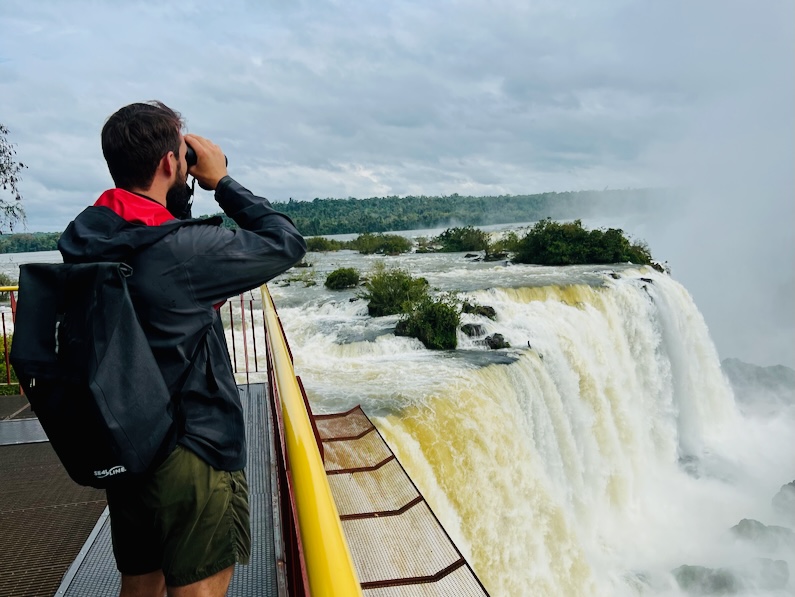
Visiting Iguazu Falls National Park in Brazil is fairly straightforward.
The simplicity of a single trail that guides visitors to various viewing platforms makes the visit very stress-free and enjoyable.
While in Brazil you have the magnificent views of the waterfalls, on Argentina’s side of the park you have the actual waterfalls.
Argentina's Iguazu Falls National Park
What makes the Argentina park experience so different from the Brazil side, is that the waterfalls of Iguazu Falls are physically in Argentina.
The whole park sits next to and above the falls.
Visiting the Argentine side of Iguazu Falls requires more planning and potentially some sacrifices given the size of the park, length of the trails, and number of viewing points.
It is difficult to do everything the park has to offer in a single day. Visitors can easily spend two days leisurely exploring.
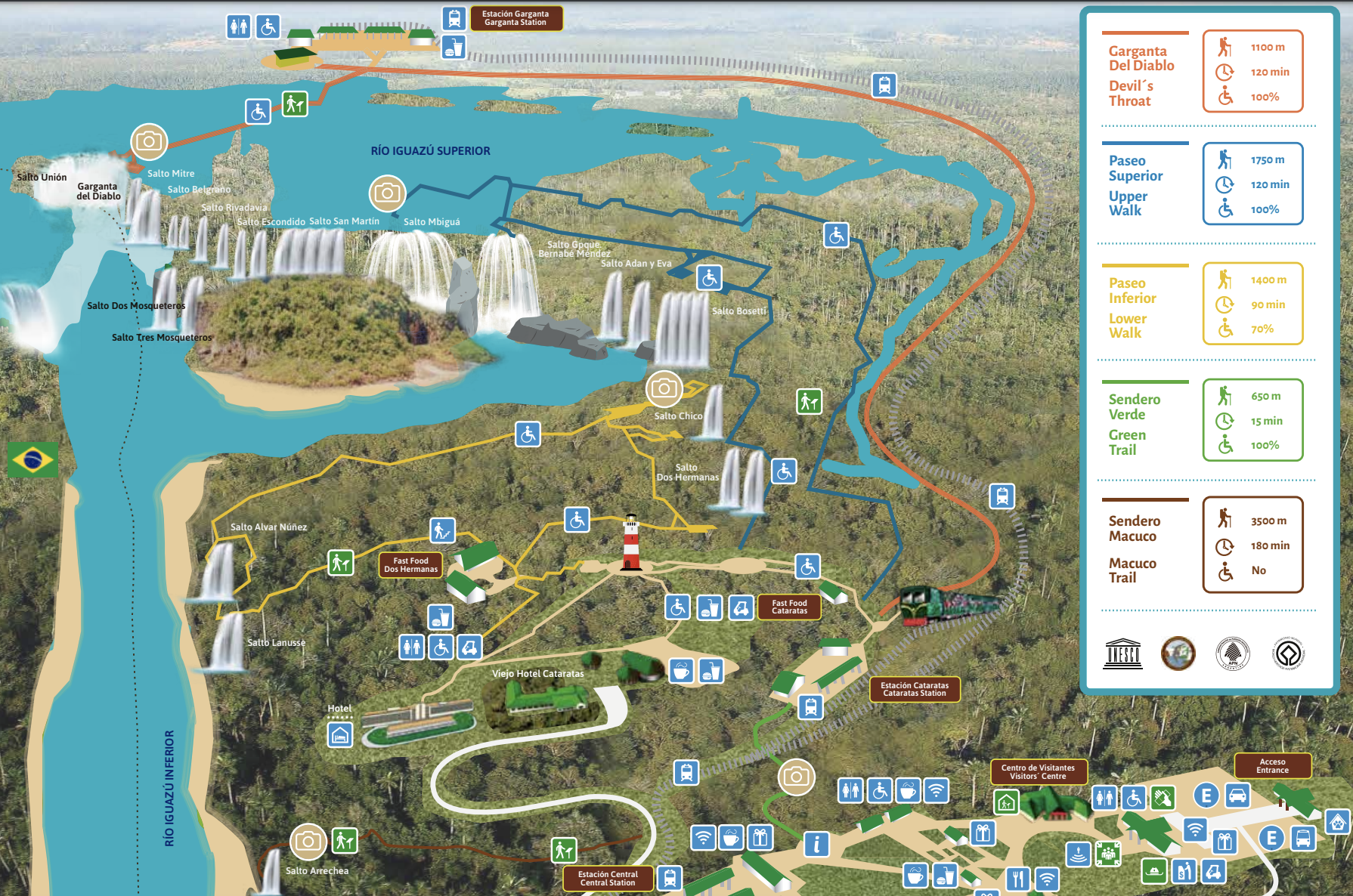
Argentina Park Map
Visiting Argentina's Iguazu Falls National Park
With just 1 day dedicated to Argentina’s park, we hoped to execute the following itinerary:
- Purchase tickets online and in advance
- Arrive at 8 am just as the park is opening
- Explore the Upper Walk (blue trail on map) and the Lower Walk trails (yellow trail on map) first
- Eat Lunch at one of the restaurants
- Walk instead of taking the train to the Devil’s Throat (orange trail on map) viewing area after lunch
- If time remained, visit the Macuco Trail (brown trail on map)
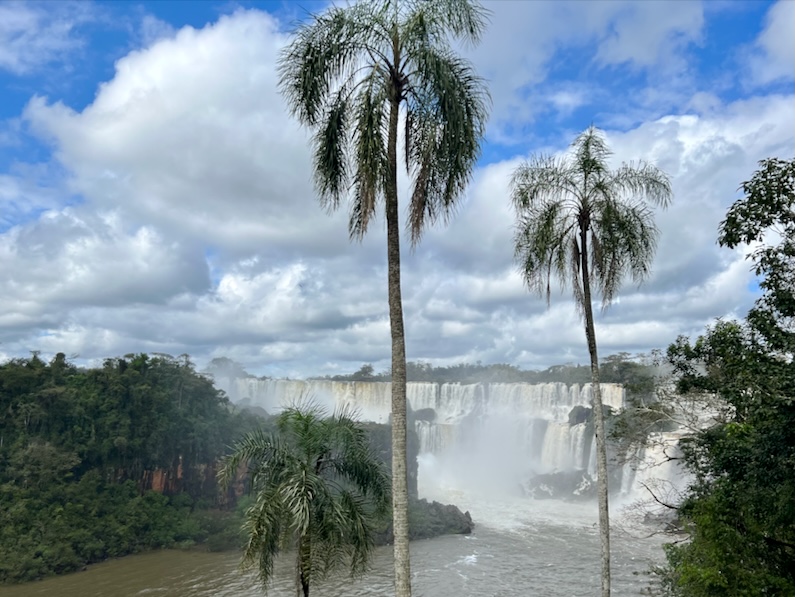
Views from Lower Trail Circuit
Our Experience in Argentina
While we enjoyed the Upper and Lower trails very much and ran into very few people on these circuits, our experience at Devil’s Throat on the Argentine side was less than ideal.
“Devil’s Throat” is where some of the biggest waterfalls meet and loudly cascade below. The viewing point sits over falls so you are looking down and into the “throat of the devil.”

Devil's Throat in Argentina
Honestly, the view at “Devil’s Throat” in Argentina didn’t feel worth the 3 hour ordeal that consisted of mostly waiting in a conveyor belt of sweaty tourists.
Once we got to the Devil’s Throat viewing area, it was nearly impossible to see anything, let alone enjoy the view of the falls.
Since the area wasn’t being seriously managed by the park, many visitors were just hanging out all along the railings and not moving to allow new visitors room to see the falls.
This created a massive traffic jam of unhappy tourists waiting to get a chance that probably never came to see the “Devil’s Throat”. Between all the pushing, toe-stepping, and yelling, I thought for sure someone’s phone might go over the railing.
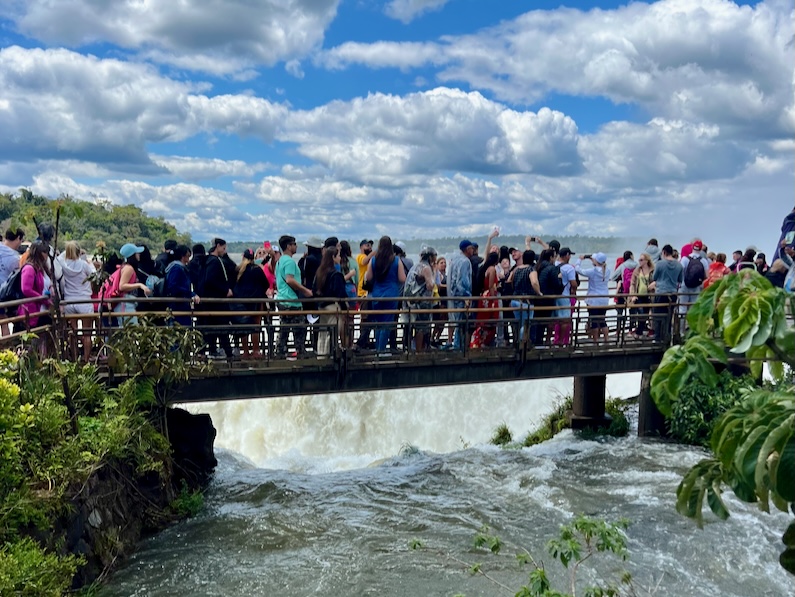
Toursits Waiting to See Devil's Throat
Lesson's Learned in Argentina
- Avoid National Holidays – If at all possible, do not visit on a national holiday or holiday weekend. We visited the park on a Friday and Monday was a national holiday in Argentina. Many Argentines took advantage of the long weekend and were visiting the falls. Can’t blame them!
- Devil’s Throat – If seeing Devil’s Throat is a priority (and it probably should be despite our experience), make it the first thing you do when you arrive, preferably right at 8 am, to avoid the crowds. You can no longer skip the Jungle or Ecological Train and walk to the Devil’s Throat.
- Isla San Martin – Tours to Isla San Martin are no longer offered.
- 50% Discount – If visiting two days in a row, validate your ticket before leaving the park on the first day to receive a 50% discount on your entry on the second day.
- Know Your Options – Before arriving, familiarize yourself with the different routes and areas of the park online. We didn’t realize how long the Upper, Lower, and Devil’s Throat trail would take and ended up not having enough time to do the Macuco Trail.
As of July 2024, Devil’s Throat trail and viewing platform in Argentina is OPEN after being closed for several months for renovations due to river levels. Hopefully these renovations improve the visitor experience.
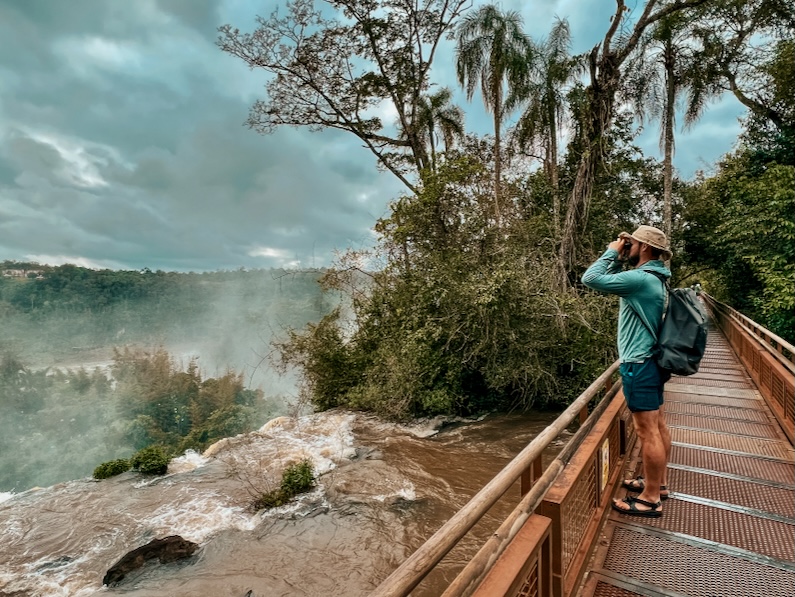
Views from Upper Trail in Argentina
Other Ways to Visit Argentina's Iguazu Falls
Full Moon Walk + Dinner (Optional) at La Selva
Similar to in the Brazil national park, Argentina offers visitors the option of purchasing park tickets that grant access to the falls in the evening between 7:45pm and 9:15pm.
More information about the full moon tickets on the ticket sales webpage.
What to Bring to Iguazu Falls National Park
- Dry bag backpack or just a dry bag to store valuables inside another bag (you and your belongings will get wet, especially at Devil’s Throat on the Brazil side.)
- Binoculares for bird watching and seeing the falls upclose
- Sunglasses
- Sunscreen
- Snacks and water bottle (there are snack kiosks and restaurants on both sides of the park serving up Brazilian and Argentine foods)
- Rain jacket or poncho
- Quick drying towel
- Sun hat
What to Wear to Iguazu Falls National Park
We visited Iguazu Falls in September which is early spring in Brazil and Argentina. Despite being spring it was still warm and humid. I suggest the following clothing options:
- Shirts and shorts that are made of a breathable, quick-dry material.
- Comfortable walking shoes that can get wet. I wore Chacos and they were the perfect shoes. Many of the metal ramps and walkways can be slippery in both parks.
- Rain jacket or poncho to stay dry from waterfall spray
That said we did see some interesting outfit choices – high heels and skin-tight clothing for example. Anything for Instagram!
Boat Tours in Iguazu Falls National Park
During our visit, we decided against doing a boat tour. Originally we thought we might visit Isla San Martin via boat on the Argentine side but we were embarrassingly told that that specific tour hasn’t existed for many years. Whoops!
Both sides of the park offer boat tours.
We have heard from friends that Brazil is less stringent when it comes to the ages and sizes of kids compared to the Argentine boat tours.
If a boat tour is of interest to you, check out these tours for more information!
Parque das Aves (Bird Park)

Entrance to Parque das Aves
Just outside Brazil’s Iguazu National Park is the only conservation center focused on Atlantic Rainforest birds.
According to Parque da Aves nearly 900 species of birds live in the Atlantic Rainforest but 41% are threatened with extinction. The park offers visitors to Iguazu Falls the unique opportunity to meet and learn more about Atlantic Rainforest birds.
Visiting Parque das Aves pairs perfectly before or after Brazil’s Iguazu Falls.
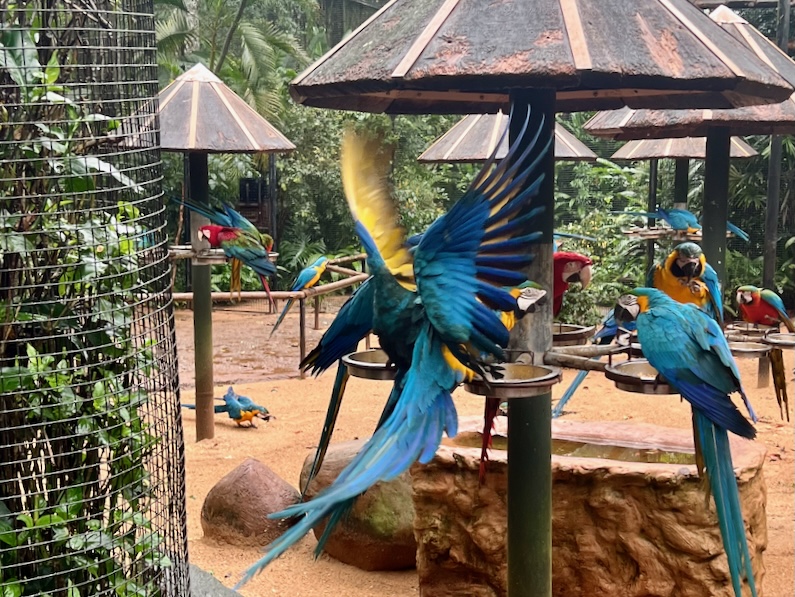
Tourist Visa Requirement in Brazil
In 2022, Brazil’s President Lula announced the return of the electronic visa for tourists from the US, Australia, and Canada beginning October 2023.
The visa start date was then delayed in January 2024 and again in April 2024. The next projected start date is April 10, 2025.
For more information about the tourist visa and how to apply, go to visitbrazil.vfsevisa.com
Iguazu Falls National Park
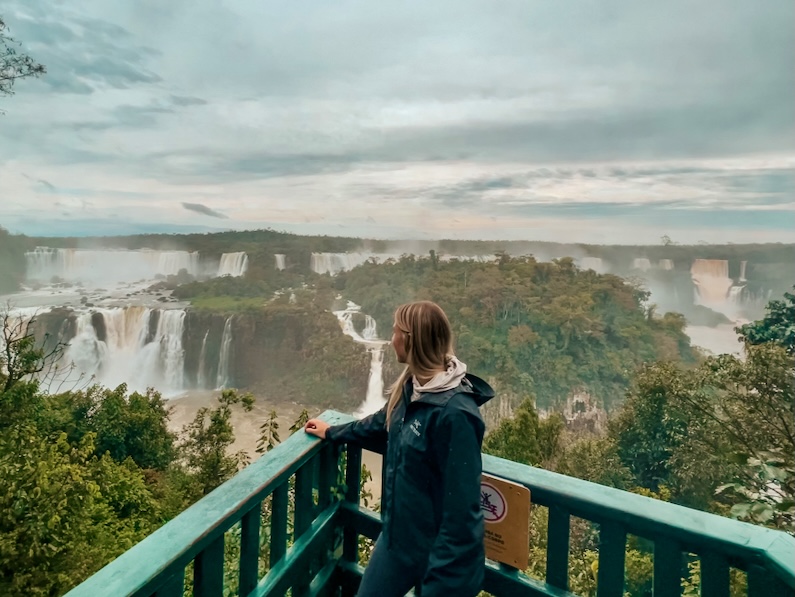
Iguazu Falls is a must visit in South America. Hopefully, our experience and lessons learned exploring both sides of the national park will help you have the most enjoyable and worthwhile trip.
Have more questions about visiting Iguazu Falls in Brazil or Argentina? Leave a comment below!
If you already visited and have more ideas on creating an unforgettable experience, also share below in the comments.
More places in Brazil to love

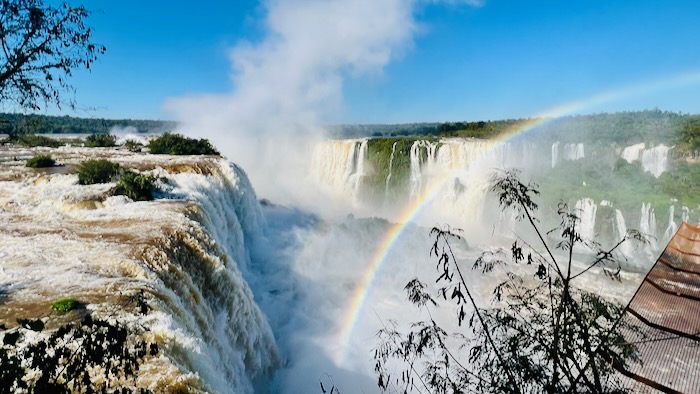
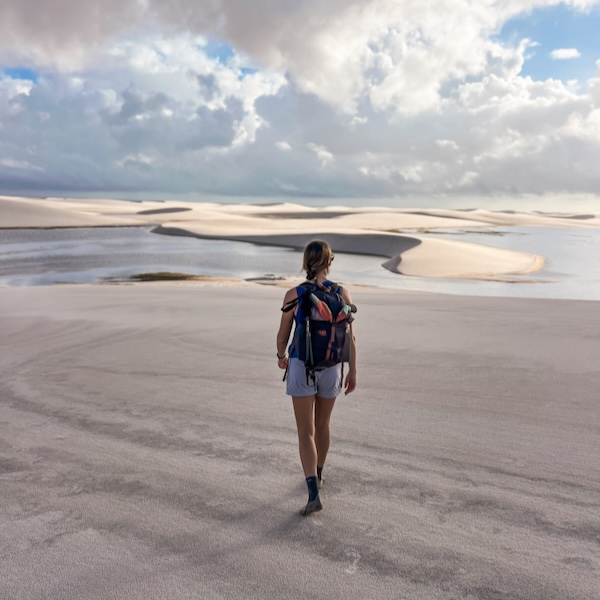


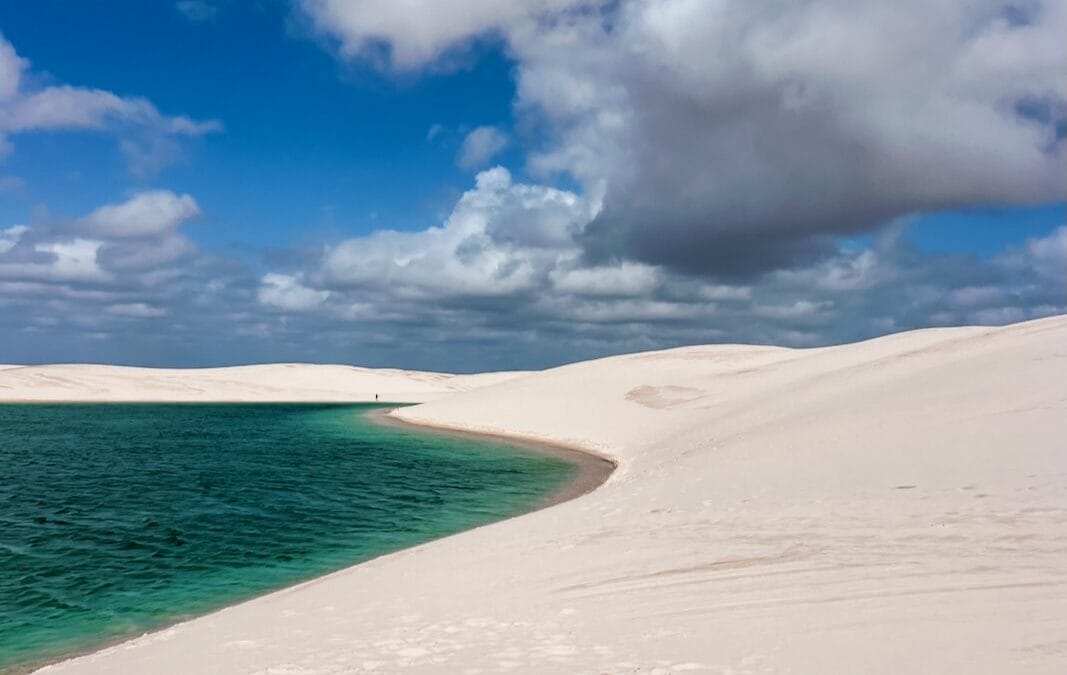
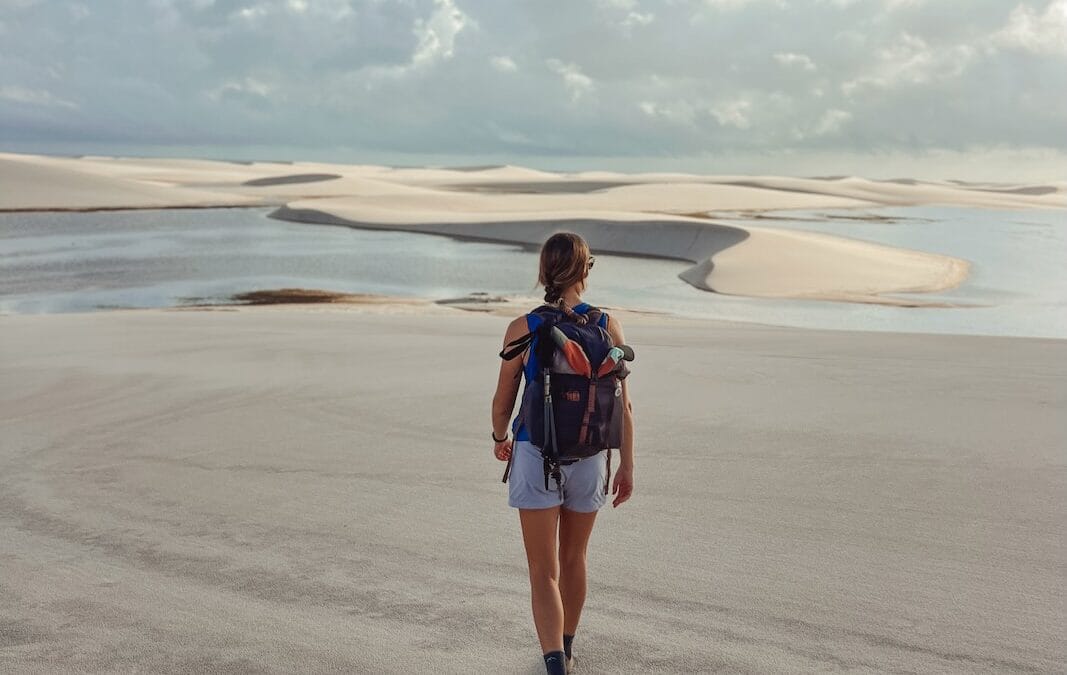
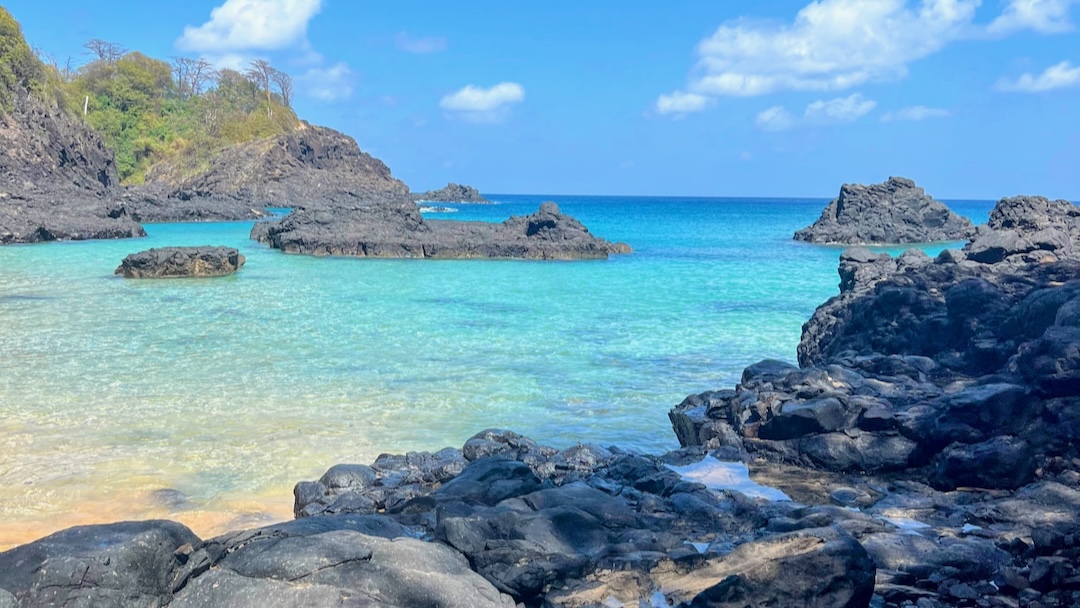
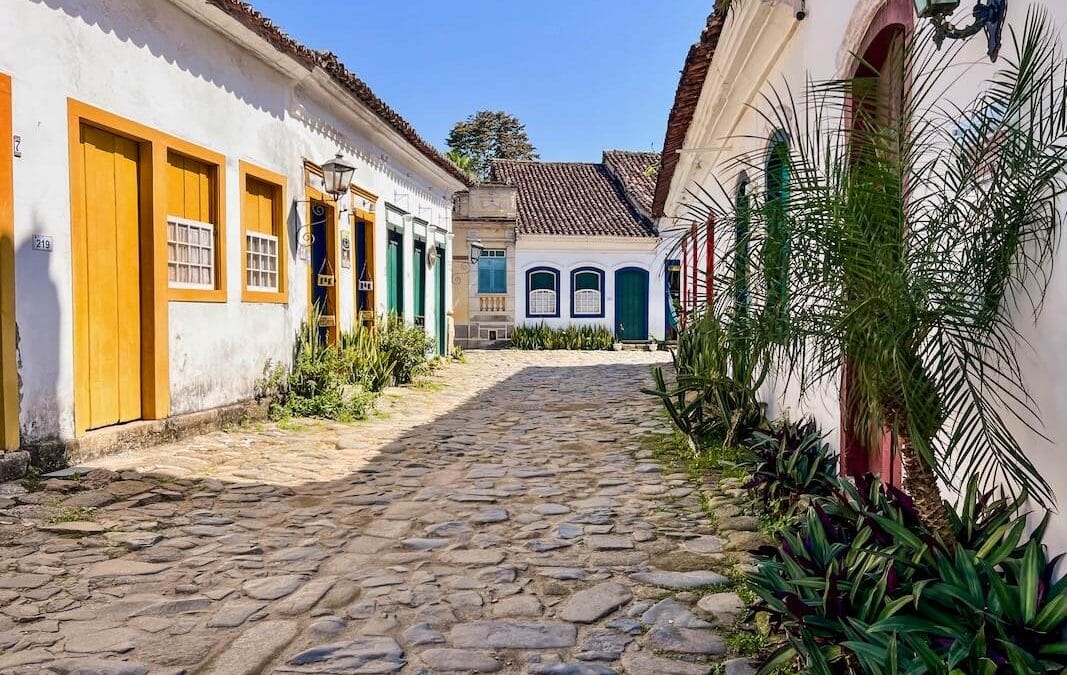
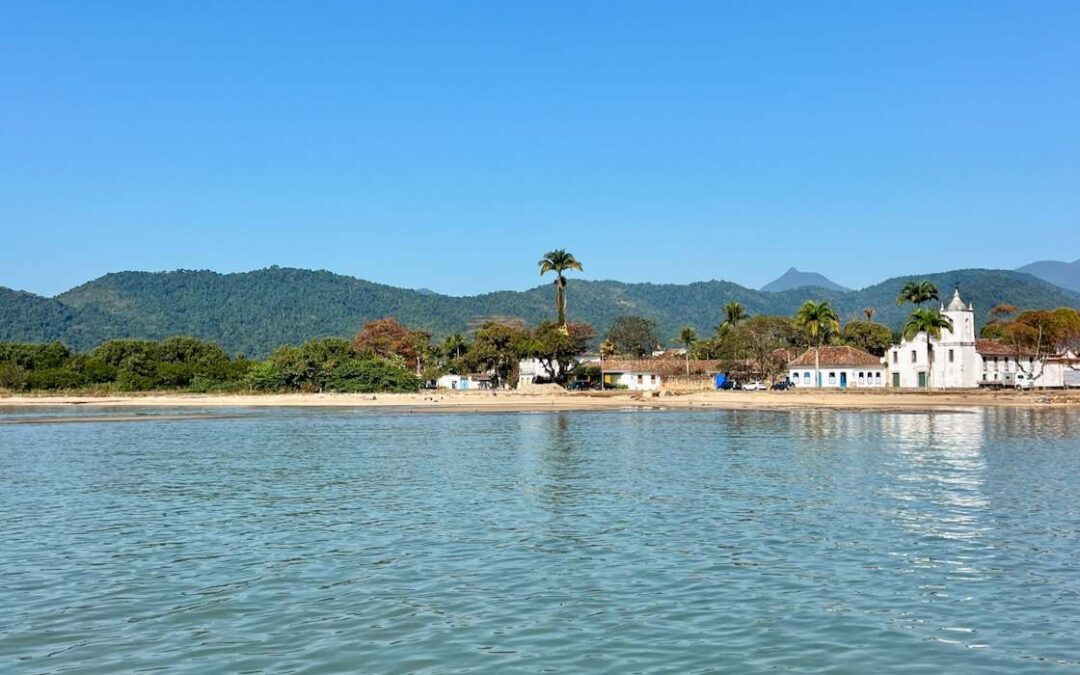
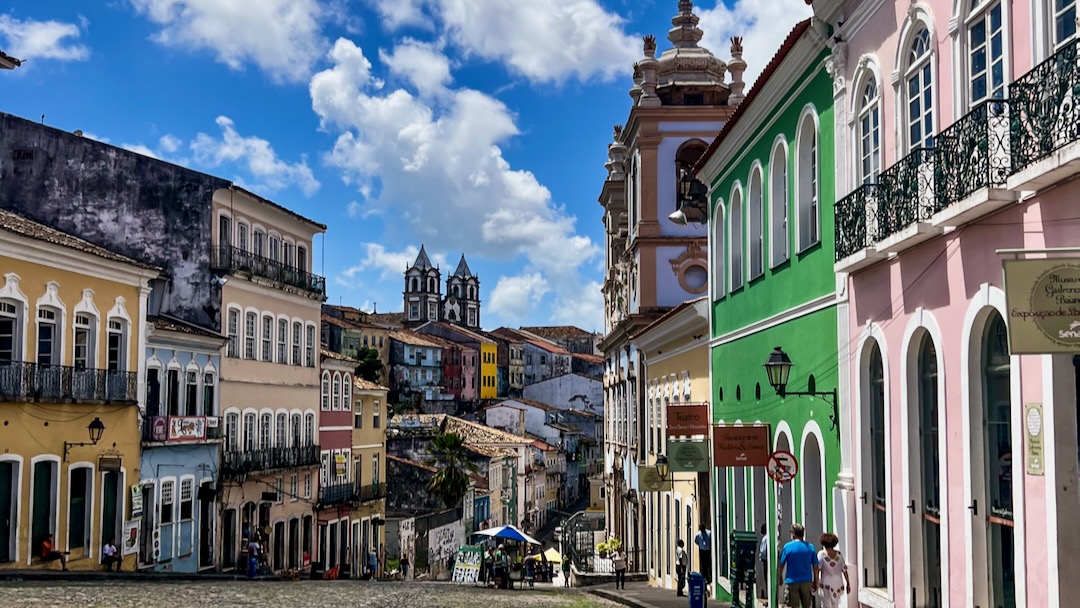
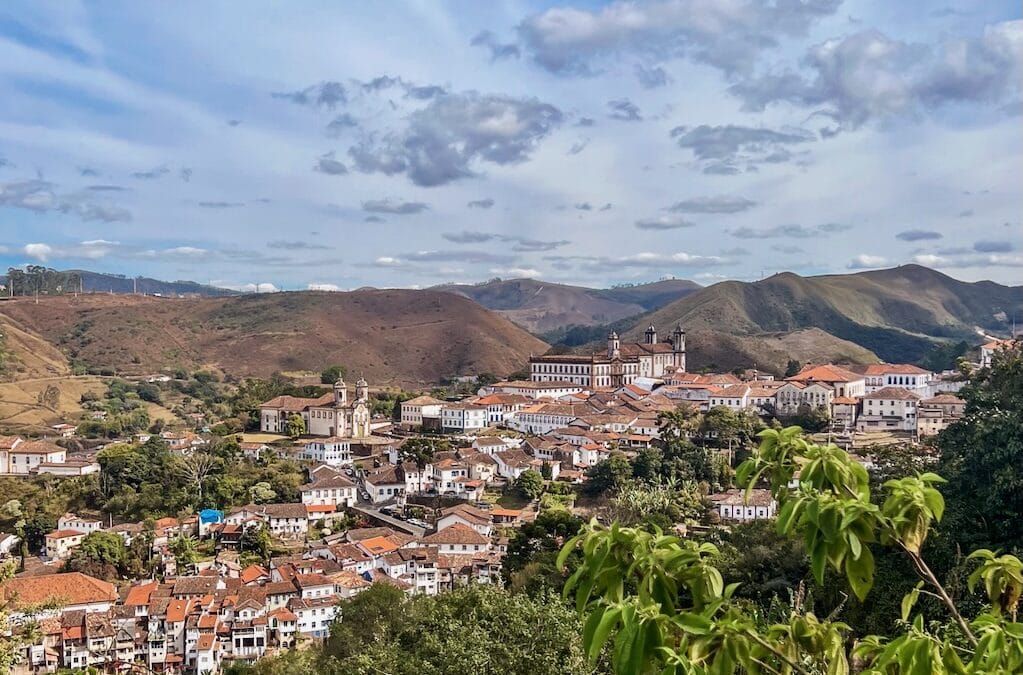
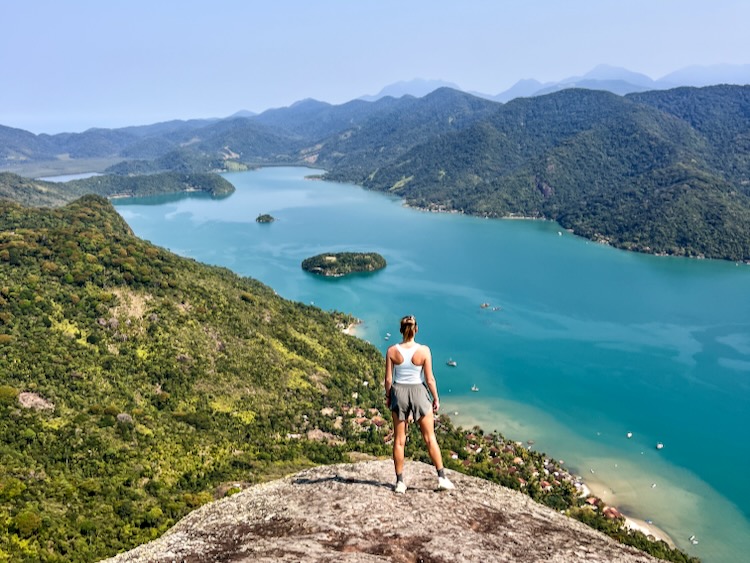
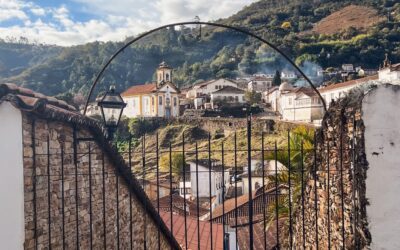

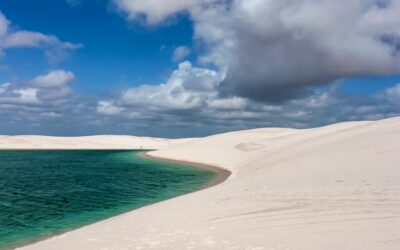
0 Comments